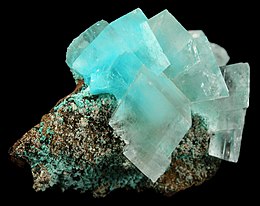| Aurichalcite | |
|---|---|
 | |
| General | |
| Category | Carbonate mineral |
| Formula (repeating unit) | (Zn,Cu)5[(OH)3|CO3]2 |
| IMA symbol | Ach[1] |
| Strunz classification | 5.BA.15 |
| Crystal system | Monoclinic |
| Crystal class | Prismatic (2/m) (same H-M symbol) |
| Space group | P21/m |
| Unit cell | a = 13.82, b = 6.419 c = 5.29 [Å] β = 101.04°; Z = 2 |
| Identification | |
| Color | Pale green, greenish blue, light blue; colorless to pale blue, pale green in transmitted light |
| Crystal habit | Typically in tufted divergent sprays or spherical aggregates, may be in thick crusts; rarely columnar, laminated or granular |
| Twinning | Observed in X-ray patterns |
| Cleavage | {010} and {100} Perfect |
| Fracture | Uneven |
| Mohs scale hardness | 2 |
| Luster | Pearly, silky |
| Streak | Light blue |
| Diaphaneity | Transparent |
| Specific gravity | 3.96 |
| Optical properties | Biaxial (−) |
| Refractive index | nα = 1.655 nβ = 1.740 nγ = 1.744 |
| Birefringence | 0.0890 |
| Pleochroism | Weak colorless to pale green |
| 2V angle | Measured: 1° to 4°, Calculated: 22° |
| References | [2][3][4] |
Aurichalcite is a carbonate mineral, usually found as a secondary mineral in copper and zinc deposits. Its chemical formula is (Zn,Cu)5(CO3)2(OH)6. The zinc to copper ratio is about 5:4.[3] Copper (Cu2+) gives aurichalcite its green-blue colors.[5]
- ^ Warr, L.N. (2021). "IMA–CNMNC approved mineral symbols". Mineralogical Magazine. 85 (3): 291–320. Bibcode:2021MinM...85..291W. doi:10.1180/mgm.2021.43. S2CID 235729616.
- ^ Handbook of Mineralogy
- ^ a b Mindat
- ^ Webmineral data
- ^ "Minerals Colored by Metal Ions". minerals.gps.caltech.edu. Retrieved 2023-03-01.